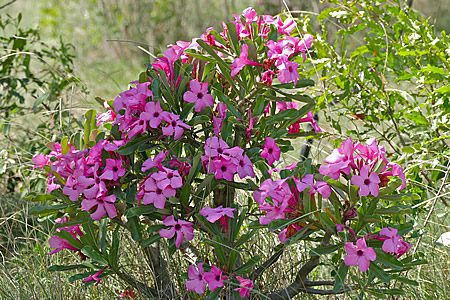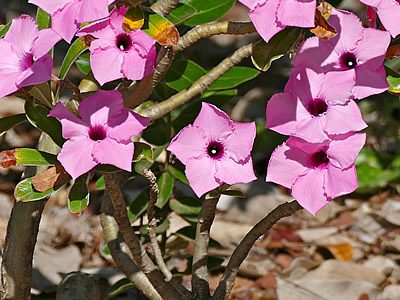The Summer Impala Lily (Adenium swazicum), also simply known as Adenium, is a succulent species from the Apocynaceae family native to Swaziland and neighboring areas of South Africa. Its flowers display a wide range of shades, ranging from a charming lilac to almost magenta. This species is notable for its hardiness, considered the hardiest among all Adenium species.
Regarding its growth habit, the Summer Impala Lily exhibits a compact pattern, although there are cultivars that show surprising variability, with delicate, trailing branches, while others gracefully rise in vertical growth. It is important to note that both the caudex and swollen roots of this species remain mainly underground, not projecting above the ground.

This stunning plant graces us with its blooming during the summer and autumn months, although some specimens bloom practically year-round. One of the distinctive features of this species is the appearance of its flowers, which display solid pink petals with a gradually darkening center, with the absence of nectar guides being notable. Furthermore, the anther appendages are short and discreet, hidden within the floral tube, a feature shared only with Adenium boehmianum. Some cultivated varieties may even have white flowers, although reports of red flowers in wild plants appear to be scarce and unknown among cultivators.
It is relevant to highlight that the Summer Impala Lily is probably the second most popular Adenium species, behind only Adenium obesum. Moreover, it is often used as a parent plant for the production of various hybrids, adding not only its ornamental characteristics but also its hardiness to its progeny.
For healthy cultivation, it is recommended to expose it to full sun, in well-drained and well-ventilated potting mix, preferably formulated specifically for desert roses or cactii and succulents. Regarding irrigation, it is important to maintain regularity, allowing the substrate to dry completely between each watering. The Summer Impala Lily exhibits a remarkable adaptability, being able to withstand harsh winters in higher altitude regions, even tolerating light frosts with little or no damage. Surprisingly, it can also endure wetter winters, a characteristic that sets it apart from other desert rose species.
During the growth and flowering periods, it is advisable to fertilize the plant with fertilizers specially formulated for desert roses and succulents, ensuring it receives the necessary nutrients for its development. However, it is important to mention that the Summer Impala Lily goes into dormancy during the winter, during which watering should be reduced, and fertilization suspended. To propagate it, you can choose between seeds or cuttings, depending on your gardening preference and experience, but remember that only plants obtained from seeds develop caudex. Similarly, we can reproduce phenotypic characteristics with consistency, such as the exact color of the flowers, only through vegetative methods, such as cuttings. By following these guidelines, you will be able to fully enjoy the beauty and resilience of the Summer Impala Lily in your collection.


